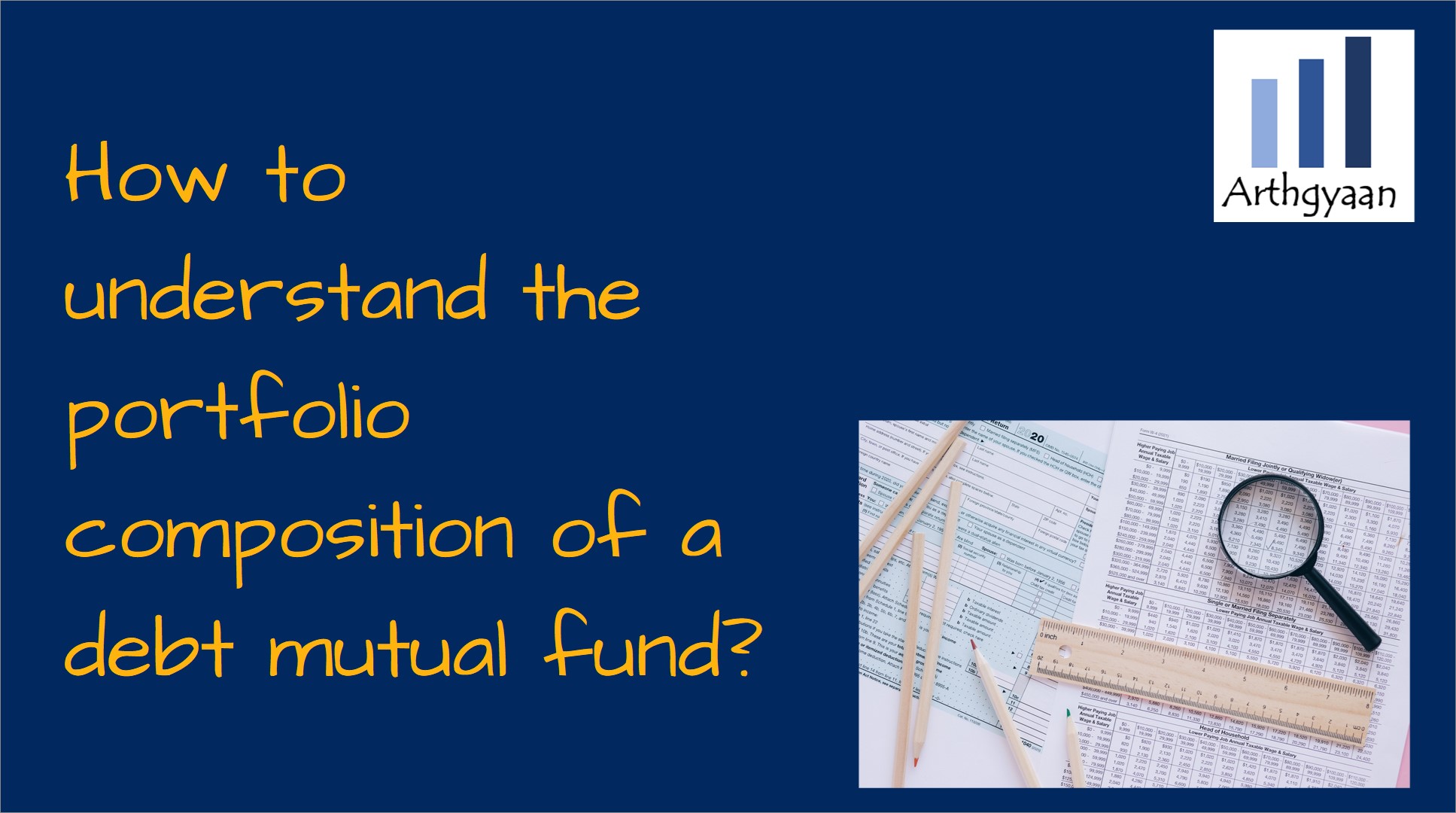How to understand the portfolio composition of a debt mutual fund?
This article teaches you how to read the portfolio disclosure statement of a debt mutual fund to understand what the fund invests in and the risk-return characteristics.
This article teaches you how to read the portfolio disclosure statement of a debt mutual fund to understand what the fund invests in and the risk-return characteristics.

Debt as an asset class is trickier to analyse and understand as compared to equity. Investing in debt mutual funds requires understanding bond-specific concepts (like duration and yield) as well as risks like credit, liquidity and interest rate risk. Debt funds require frequent monitoring via portfolio disclosure statements published every fortnight. At the very least, forward returns are determined by the current portfolio parameters like duration and YTM vs. return history. This is a point many investors, especially those who compare returns of FDs with debt MF, commonly miss.
There are three things to keep in mind when choosing a debt fund:
• what is allowed to be in the portfolio: this is defined and regulated by SEBI and is covered in our introductory article on debt funds
• what is currently in the portfolio: you will get this information by reading the portfolio disclosure statement of the fund as we cover in this article
• what is the history of changes in the portfolio: this analysis indicates how the fund manager is staying within the SEBI parameters while simultaneously maximising return/risk opportunities
Fund portfolio disclosure statements are documents published by the mutual fund AMC at least once a month. The statement shows what the fund is currently invested in, what is the proportion of investments in each asset, the benchmark used and the risk profile of the portfolio.
As per SEBI regulation, debt fund portfolio disclosure statements are published by the AMC every fortnight. The AMC sends notifications to each investor by email and also uploads them to its website.
AMCs need to disclose their mutual fund portfolios to be in compliance with SEBI Circular no. SEBI/HO/IMD/DF3/CIR/P/2020/130 dated July 22, 2020, SEBI/HO/IMD/IMD-II DOF3/P/CIR/2021/555 dated April 29, 2021 and SEBI/HO/IMD/IMD-II DOF3/P/CIR/2021/621 dated August 31, 2021.
AMCs generally disclose the mutual fund portfolios in Excel format on their website
Using an example of a money-market debt fund, here are the explanations for the various sections:
We describe each field below:
The notes provide some useful information:
The risk-o-meter is a SEBI innovation that shows the risk of the fund using a 6-point scale from Low to Very High. While this metric is useful to some investors, others should, in the absence of quantitative risk classification data, use this data solely for checking for changes in risk. If the risk-o-meter value has suddenly changed, it could be a cause for concern.
This section also contains the portfolio benchmark information and the risk-o-meter values of the benchmark(s). Investors should track that the fund risk-o-meter is the same as that of the benchmark.
SEBI on Jun 07, 2021, amended the regulations for the classification of debt funds to better allow investors to understand the risks when choosing one. These new classifications are effective since December 2021. As per the new SEBI criteria, risk in debt funds is classified on Credit risk and Interest Rate risk. These risks are combined into a matrix called the Potential Risk Class matrix.
Read more on this concept here:
How to use the SEBI Potential Risk Class matrix to understand risk in debt mutual funds?
Here is a live example: Franklin India Ultra Short Duration Fund portfolio analysis: Is Franklin Templeton creating the same portfolio that shut its funds in Apr 2020?
Estimated return from the debt fund in 1 year: (YTM - TER) - D * ChangeInRates
where ChangeInRates > 0 for increases in rates and TER is the expense ratio of the fund. The minus sign in front of D signifies that the return falls when rates rise and vice versa.
For some typical numbers,
YTM = 4%, TER = 0.2%, D = 0.16, Change = .5%,
expected return = 4 - 0.2 - 0.16 * .5 = 3.72% in 1 year before taxes.
One of the most useful features of the portfolio disclosure statement is that it lists every bond in the portfolio that includes the maturity date, credit quality and overall exposure of the portfolio to a particular company, group of companies or issuer. This list gives the investor an opportunity to look for cases where:
Fund portfolio disclosure statements are documents published by the mutual fund AMC at least once a month. The statement shows what the fund is currently invested in, what is the proportion of investments in each asset, the benchmark used and the risk profile of the portfolio.
As per SEBI regulation, debt fund portfolio disclosure statements are published by the AMC every fortnight. The AMC sends notifications to each investor by email and also uploads them to its website.
AMCs need to disclose their mutual fund portfolios to be in compliance with SEBI Circular no. SEBI/HO/IMD/DF3/CIR/P/2020/130 dated July 22, 2020, SEBI/HO/IMD/IMD-II DOF3/P/CIR/2021/555 dated April 29, 2021 and SEBI/HO/IMD/IMD-II DOF3/P/CIR/2021/621 dated August 31, 2021.
AMCs generally disclose the mutual fund portfolios in Excel format on their website
1. Email me with any questions.
2. Use our goal-based investing template to prepare a financial plan for yourself.Don't forget to share this article on WhatsApp or Twitter or post this to Facebook.
Discuss this post with us via Facebook or get regular bite-sized updates on Twitter.
More posts...Disclaimer: Content on this site is for educational purpose only and is not financial advice. Nothing on this site should be construed as an offer or recommendation to buy/sell any financial product or service. Please consult a registered investment advisor before making any investments.
This post titled How to understand the portfolio composition of a debt mutual fund? first appeared on 23 Oct 2022 at https://arthgyaan.com